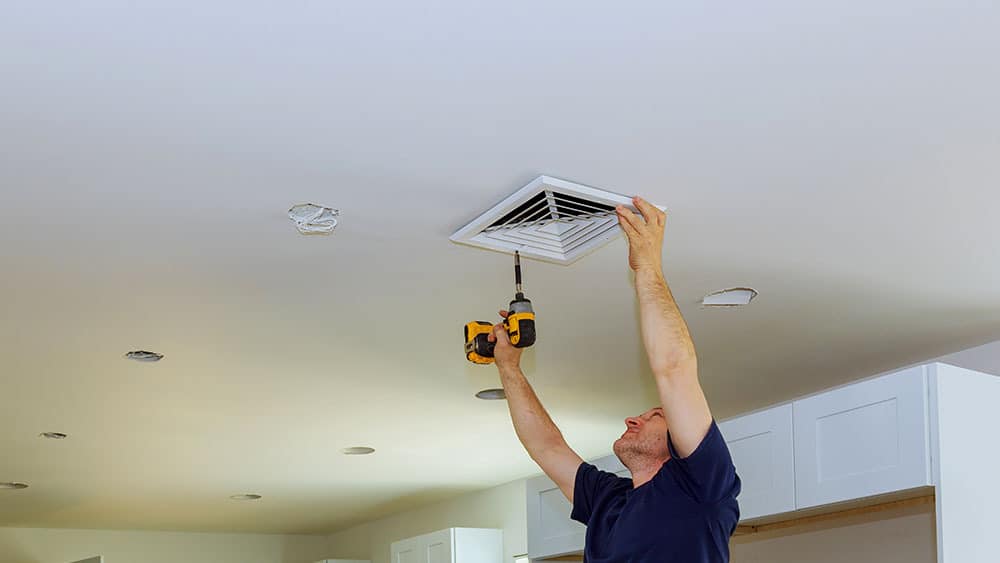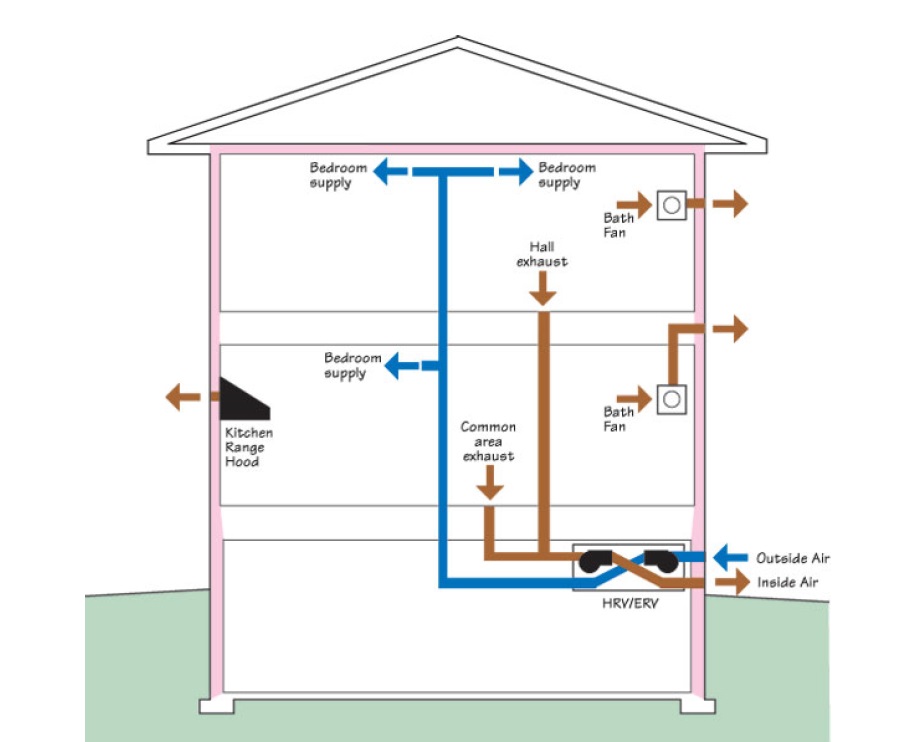Home Ventilation Melbourne Strategies to Combat Indoor Air Pollution
Wiki Article
Exploring Innovative Solutions for Optimal Home Ventilation Equipments
Home ventilation plays an important role in keeping health and convenience within living rooms. With developments in technology, ingenious services are emerging to optimize these systems. Smart air flow, energy recovery ventilators, and progressed purification are improving how air high quality is handled - Home Ventilation Melbourne. Nonetheless, the combination of these innovations elevates concerns regarding their effectiveness and adaptability in varied home settings. What effects do these developments hold for future living requirements?The Importance of Home Air Flow for Health And Wellness and Comfort
Frequently ignored, home air flow plays an important role in preserving both health and wellness and comfort within domestic spaces. Appropriate ventilation is vital for the flow of fresh air, which assists to thin down indoor toxins such as unstable natural substances, irritants, and odors. Without correct air movement, these impurities can gather, bring about breathing concerns and other health and wellness problems. Additionally, effective ventilation adds to managing moisture levels, preventing mold and mildew growth and architectural damage. By guaranteeing a balanced exchange of air, locals can appreciate an extra positive interior environment, enhancing general health. Moreover, adequate ventilation can boost power efficiency by reducing the requirement for too much heating or cooling, ultimately causing reduced energy costs and a more lasting living space.Smart Ventilation Equipments: Harnessing Modern Technology for Efficiency
Smart ventilation systems represent a substantial development in home air administration, leveraging IoT assimilation for boosted control. These systems not only promote power effectiveness however also provide remote monitoring capabilities, allowing users to enhance their indoor atmospheres perfectly. By utilizing innovation, house owners can attain enhanced air quality while lowering power intake.IoT Assimilation Benefits
How can IoT combination change standard air flow systems right into very reliable smart options? By integrating Web of Things (IoT) modern technology, air flow systems can accomplish real-time surveillance and control, boosting their functional effectiveness. Sensing units positioned throughout a home gather data on air humidity, temperature, and high quality, permitting automated modifications based upon current conditions. This instant responsiveness causes boosted interior air top quality and comfort levels. In addition, IoT-enabled systems can connect with other smart home gadgets, producing a natural ecological community that maximizes power usage. Users can additionally gain access to and manage their ventilation systems remotely by means of smartphones, offering convenience and boosted control. Overall, IoT integration represents a substantial advancement, bringing intelligence and adaptability to traditional air flow practices.Energy Effectiveness Features
As power efficiency becomes a crucial emphasis in contemporary home design, advanced air flow systems supply cutting-edge functions that substantially reduce energy usage. These clever air flow systems utilize sensing units to monitor interior air humidity, temperature, and high quality degrees, automatically changing airflow to preserve excellent conditions. By employing energy recovery ventilators (ERVs), they record and recycle power from outward bound air, lessening home heating and cooling down needs. Variable rate fans better enhance performance by readjusting their operation based upon real-time requirements, preventing unneeded energy waste - Home Ventilation Melbourne. Furthermore, programmable timers and occupancy sensing units assure that air flow operates only when necessary, contributing to lower energy bills. Jointly, these attributes represent a substantial development in producing energy-efficient and sustainable living environmentsRemote Surveillance Capabilities
What advantages do remote surveillance abilities bring to modern-day home air flow systems? These capabilities allow property owners to track interior air high quality and system efficiency in real time, improving general performance. By supplying data on air, temperature level, and moisture pollutants, clever air flow systems make it possible for positive adjustments, ensuring ideal conditions. Additionally, remote monitoring promotes upkeep signals, recognizing potential concerns before they escalate, therefore minimizing repair prices and downtime. Users can access system analytics through mobile applications, enabling hassle-free control even when away from home. This technical assimilation not only promotes energy effectiveness yet likewise adds to a much healthier living environment. Inevitably, remote surveillance capacities stand for a considerable advancement in home ventilation, lining up with the expanding need for smart home technologies.Energy Healing Ventilators: Making Best Use Of Power Savings
Energy recovery ventilators (ERVs) play a crucial duty in improving home power efficiency with reliable warmth exchange. By transferring thermal energy in between incoming and outgoing air, these systems significantly minimize general energy consumption. This innovative approach not only preserves interior air top quality yet also adds to decrease energy costs.Effectiveness of Heat Exchange
While preserving indoor air quality is vital for health and wellness and comfort, the performance of heat exchange in energy recuperation ventilators (ERVs) plays a crucial duty in maximizing power cost savings. The main function of an ERV is to transfer heat and moisture between inbound and outbound jet stream, which enhances indoor problems while minimizing energy loss. High-efficiency warmth exchangers can substantially lower the tons on heating and cooling systems by redeeming power that would certainly otherwise be wasted. The effectiveness of these systems is often measured by their core temperature currency exchange rate, which can vary based upon layout and materials used. By focusing on innovative warm exchange modern technologies, home owners can enhance their air flow systems, bring about enhanced power effectiveness and price decreases over time.Reduced Energy Intake
Minimizing energy intake is a key benefit of power recovery ventilators (ERVs), as they effectively recycle thermal power from exhausted air. By moving heat in between incoming and outbound air streams, ERVs minimize the requirement for extra heating or air conditioning, causing substantial energy savings. This process not just lowers energy costs but additionally minimizes the ecological effect associated with higher power usage. Additionally, ERVs maintain consistent interior air high quality without compromising thermal convenience, producing a well balanced living atmosphere. By integrating ERVs into home air flow systems, homeowners can attain better energy effectiveness, allowing a sustainable approach to interior air management while taking advantage of lower power costs. Ultimately, ERVs stand for a compelling service for energy-conscious consumers.Advanced Filtration Technologies for Cleaner Indoor Air
As indoor air quality becomes increasingly recognized as a crucial element of health and wellness and wellness, progressed filtering technologies are becoming important tools for guaranteeing cleaner atmospheres. These modern technologies consist of high-efficiency particulate air (HEPA) filters, turned on carbon filters, and electrostatic precipitators, each designed to efficiently record air-borne toxins, irritants, and unstable organic substances (VOCs) HEPA filters can catch particles as small as 0.3 microns, considerably minimizing irritants like dirt termites and family pet dander. Turned on carbon filters stand out in adsorbing smells and chemical vapors, contributing to a fresher interior ambience. Additionally, electrostatic precipitators use electric fees to get rid of particles, giving an energy-efficient choice. By integrating these advanced purification systems, property owners can enhance indoor air top quality and advertise healthier living areas.The Role of Sensing Units in Maximizing Airflow and High Quality
Just how can sensors change the management of indoor air top quality? Sensing units play a necessary role in improving air flow and enhancing interior atmospheres. By continuously keeping track of aspects such as humidity, temperature level, and degrees of pollutants, they provide real-time data that notifies ventilation systems. This information allows automatic modifications to airflow, ensuring appropriate flow and minimizing the buildup of impurities. In addition, advanced sensing units can detect particular air top quality concerns, triggering instant responses to enhance convenience and health. The assimilation of these tools right into air flow systems permits for a much more effective and receptive management strategy, minimizing power intake while preserving ideal air quality. Inevitably, sensing units work as an important element in producing much healthier indoor rooms through precise air movement law.Incorporating Air Flow With Smart Home Systems
While numerous home owners look for ease and performance, incorporating ventilation systems with smart home innovation uses an innovative solution to managing indoor air quality. By connecting ventilation devices to smart home hubs, homeowners can automate site air quality monitoring and control air flow based on real-time data. These systems can reply to changes in pollutant, temperature, and moisture levels, making sure suitable interior conditions. Smart thermostats can operate in tandem with air flow systems to improve power effectiveness, reducing costs while maintaining comfort. Property owners can additionally remotely manage their air flow setups with mobile apps, offering versatility and satisfaction. Eventually, this assimilation not just simplifies administration yet greatly boosts the total living atmosphere, making it an important addition to contemporary homes.Future Patterns in Home Air Flow Solutions
Emerging modern technologies and heightened awareness of indoor air high quality are shaping the future of home air flow solutions. One considerable pattern is the combination of expert system, enabling systems to change air flow based on real-time useful content information and tenancy patterns. In enhancement, power healing ventilators are getting grip, giving reliable air exchange while reducing energy loss. Using eco-friendly materials and styles is likewise growing, straightening with sustainability goals. Smart sensing units that check pollutants and humidity levels are coming to be criterion, permitting house owners to keep suitable interior atmospheres. Furthermore, modular and scalable systems are arising, giving adjustable options for numerous home dimensions and configurations. Home Ventilation Melbourne. With each other, these developments guarantee to boost convenience, efficiency, and health in residential spacesOften Asked Inquiries
Exactly how Commonly Should I Clean My Home Ventilation System?

The frequency of cleaning up a home ventilation system differs based upon usage and atmosphere. Normally, it is suggested to cleanse the system every 3 to six months to preserve ideal air top quality and system performance.
Can Poor Ventilation Reason Mold And Mildew Growth Inside Your Home?

What Are the Indicators of Inadequate Home Ventilation?
Signs of insufficient home ventilation consist of persistent smells, enhanced humidity degrees, condensation on home windows, visible mold development, and a basic sensation of stodginess. These indications often suggest that air flow wants for keeping a healthy and balanced indoor environment.Just How Can I Improve Air Flow in Older Residences?
To boost air flow in older homes, one may take into consideration setting up exhaust fans, using all-natural airflow through windows, sealing spaces for far better air control, and incorporating air purifiers to improve indoor air top quality efficiently.Are DIY Ventilation Solutions Effective and Safe?

Smart ventilation, power healing ventilators, and progressed filtering are improving exactly how air high quality is handled. As power effectiveness becomes an essential focus in modern home style, advanced ventilation systems use ingenious attributes that considerably decrease energy usage. By integrating ERVs right into home ventilation systems, property owners can accomplish greater power performance, enabling a sustainable approach to indoor air administration while profiting from reduced power bills. The integration of these gadgets right into air flow systems allows for a more efficient and responsive management approach, lowering energy intake while preserving suitable air top quality. While several homeowners seek ease and efficiency, incorporating air flow systems with wise home modern technology offers an review innovative remedy to managing interior air top quality.
Report this wiki page